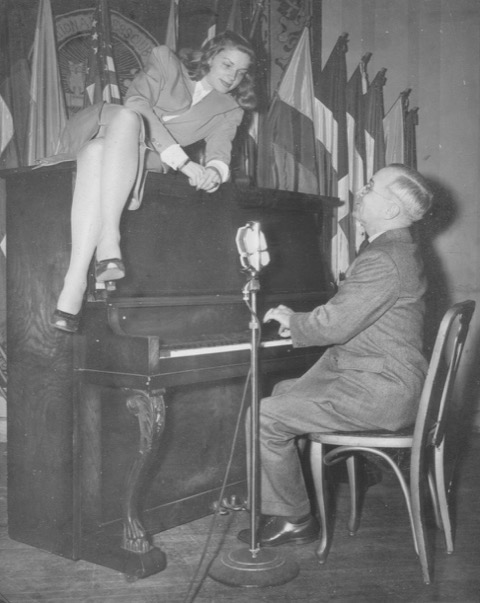While the National Press Club was the nerve center for wartime Washington journalism from the moment members gathered on the morning of the attack on Pearl Harbor, the Club is best known for a series of Saturday canteens during the war organized by the Club’s American Legion Post 20 to entertain servicemen.
Soldiers, sailors and airmen from bases throughout the region congregated at the Club for free hotdogs and beer. Politicians could come, but they could not speak for more than two minutes. Big-name entertainers began to show up.
It all began in November, 1942 when the Club received a call from the chaplain of the H.M.S. Essex, then being refitted at the Norfolk Navy Yard. The chaplain had 80 sailors seeking to come to Washington for sightseeing. Where should they go for entertainment? A few members got together, arranged for the sailors to come to the Club and drink all the beer they could hold.
It was such a hit that the Club quickly made it a weekly affair sponsored by its American Legion Post 20, which had been formed in 1919 with World War I veterans and included Gen. John J. Pershing as an original dues-paying member.
Dubbed the National Press Club Canteen, every Saturday the ballroom was open to any American or Allied serviceman who wanted to come. It soon became a principal port of call for every soldier or sailor on weekend leave. Up to 700 showed up each week.
The affair was for enlisted men. No brass need apply. But the Club thought the servicemen would like to see some representatives of the nation who were sending them around the world to fight. Senators, representatives, Cabinet members, and even eight out of nine members of the Supreme Court showed up. (Some of the men found it amusing that they were eating frankfurters with Justice Felix Frankfurter.).
Military bands – the Marine Band, the Army Band, the Air Corps Band, the Coast Guard Band -- entertained. Bands from local military bases appeared.They played boogie-woogie. Entertainers showed up for impromptu performances, including the entire chorus of Earl Carrol’s Follies.
And that brings us to Feb.10, 1945.
Lauren Bacall’s big breakthrough hit, “To Have and Have Not,” had just been released. She and Humphrey Bogart had begun an affair that was capturing some headlines. As part of the movie’s publicity, Warner Bros. studio wanted her to appear at the Press Club Canteen. At first, she balked, saying she wanted to be with Bogie, but after a personal appeal from Jack Warner, she relented. Her press agent Charles Einfeld came with her.
At the same time, Truman, still relatively unknown after Roosevelt plucked him out of the Senate to be his running mate, was living in an apartment on Connecticut Avenue. He had been Vice President for three weeks. He told his wife, Bess, that he was going to the Press Club to entertain the troops. After all, he was an accomplished piano player. It was an all-men’s Club. How could he get in any trouble?
In her memoir, “By Myself and Then Some,” Bacall remembered the day this way:
“The club was jammed that day – Vice President Truman was coming over. When he was introduced – after me! – he sat down to play the piano, which had conveniently been placed onstage. Charlie, who was standing to one side of the floor, edged toward me on the corner of the stage and said, ‘Get on the piano.’ I felt a bit silly … but I did it. Cameras started flashing. The Vice President and I exchanged a few words, and the resulting pictures hit the front pages all over the world in a few days, Charlie Einfeld was worth every cent and more that Warner paid him. Truman was not wild about the picture after he became President, but I loved it.”

